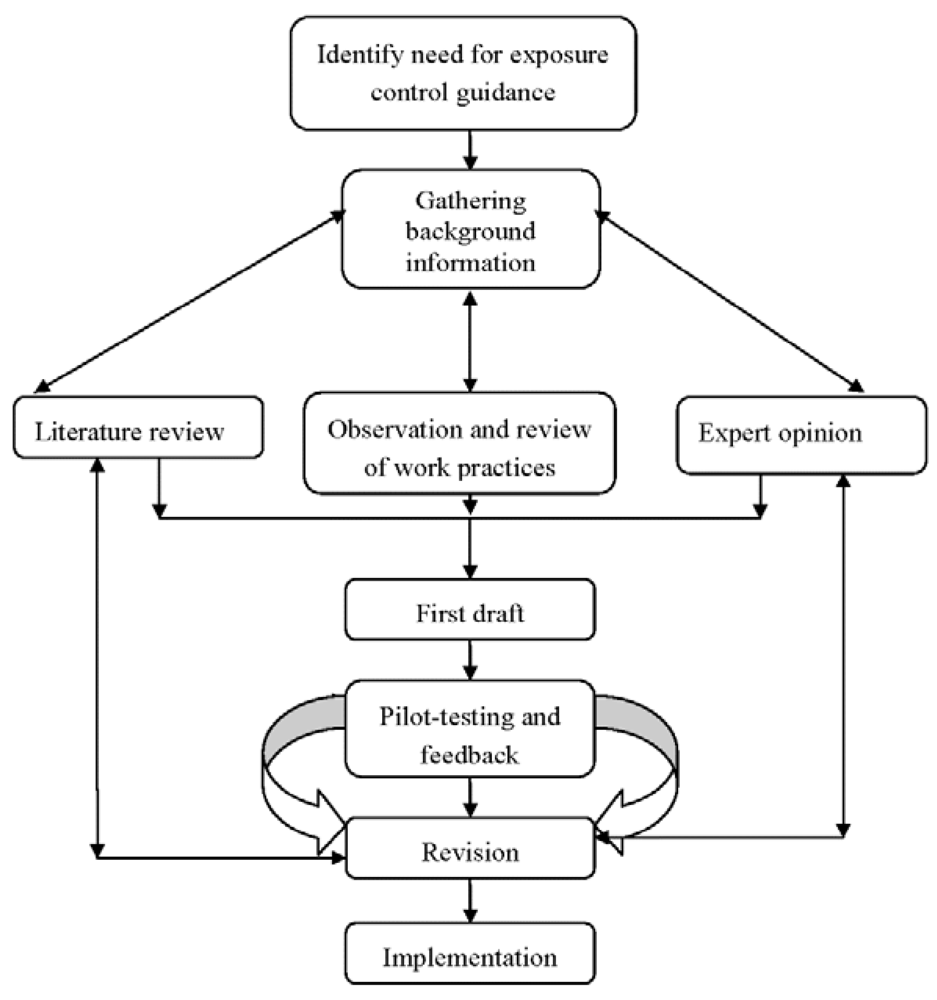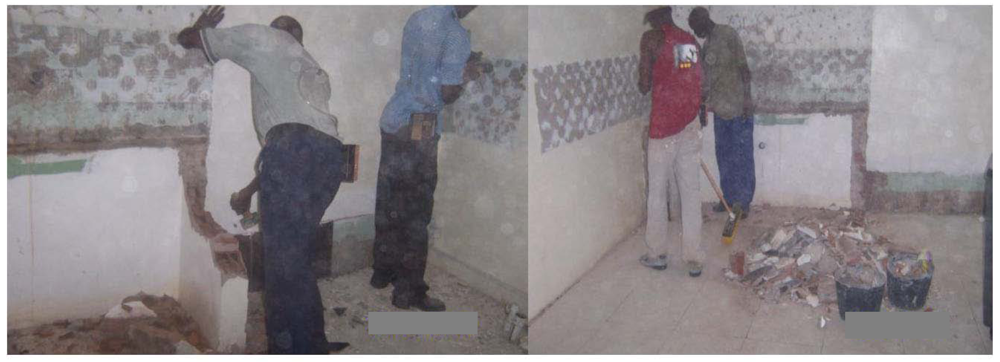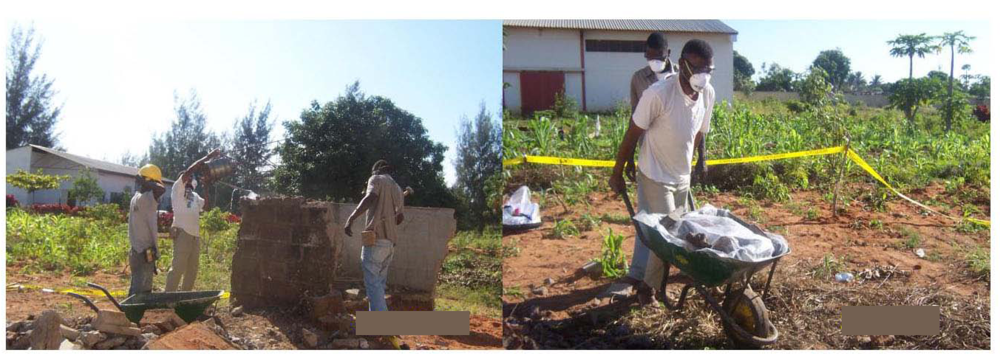Checklist Model to Improve Work Practices in Small-Scale Demolition Operations with Silica Dust Exposures
Abstract
:1. Introduction
2. Methods and Materials
2.1. Steps for Developing Exposure Control Guidance

2.1.1. Identifying Need
2.1.2. Gathering Background Information
2.1.3. Writing First Draft
2.1.4. Pilot-Testing and Feedback
2.1.5. Revision(s)
2.1.6. Implementation
2.2. Steps for Evaluation of the Control Guidance
2.2.1. Development of Walkthrough Guide to Assess Control Guidance Use
2.2.2. Training of Observers/Data Collectors
2.2.3. Pretraining Assessment of Work Practices
2.2.4. Worker Training and Target Population
2.2.5. Posttraining Assessment of Work Practices
3. Results
3.1. Steps for Developing Exposure Control Guidance
3.1.1. Identifying Need
3.1.2. Background Information
3.1.3. Writing First Draft
3.1.4. Pilot-Testing and Feedback
3.1.5. Revision(s)

3.1.6. Implementation
3.2. Evaluation of Control Guidance
| # | Evaluation level | Results for each level |
|---|---|---|
| I | Attendance | 25 workers achieved 100% and one achieved 97.6% of attendance. |
| II | Formative evaluation | Stakeholders in U.S. and Mozambique provided input and support for the development, implementation and evaluation of checklists. |
| III | Satisfaction and opinion of the trainees | 54% of all participants, provided feedback *. Thirteen of 14 (93%) trainees were satisfied. 93% of trainees rated the training and the work practice components in the checklist to be “useful” and “effective”. Of the controls presented, water to suppress was rated highest, as extremely useful or useful by 71 and 21% of trainees respectively. Only one trainee considered training difficult. 36% of trainees considered the facilitator not flexible with the agenda. All trainees proving written feedback indicated the need for regular training for themselves and other workers exposed to dust. |
| IV | Knowledge acquisition | 12% of trainees indicated knowledge before training and 100% of trainees indicated knowledge of silica dust exposure prevention and controls after the training. The difference of proportion was statistically significant (p < 0.01). |
| V | Skills acquisition | Two participants missed items during preplanning tasks and one participant missed an item during the check after task completion. After reexplanation and demonstration all the steps were successfully completed. Trainees mastered the use of task-based good work practice guidance sheets. Observers and investigator results were similar and consistent. |
| VI | Transfer of learning to the workplace | Pretraining: work practice components used: 8%. Posttraining: Work practice components used: 63%. |
| VII | The impact of the training | Work practice components used: 67 to 71% units of change after training. The difference of proportions pre-and-post training was statistically significant (p < 0.05). |
| # | Components of good work practice control guidance sheets | Timing of Observations | |
|---|---|---|---|
| Before | After | ||
| 1 | Preplanning | – | + |
| Displaying warning signs, checking if all tools and supplies are available and functioning well | – | + | |
| 2 | Water for dust suppression | – | + |
| Water hose spray | – | + | |
| Sprinkling by hand or other appropriate resources | – | + | |
| Wet wiping | – | + | |
| 3 | High efficiency particulate air (HEPA) filter vacuum | – | – |
| 4 | Natural ventilation | ||
| Free air circulation (doors and windows open if possible) | – | + | |
| Working upwind/upstream of the dust‑generating source | – | + | |
| 5 | Basic personal protective equipment (PPE) | ||
| Safety glasses with side shields | – | + | |
| Hard hat | – | + | |
| Safety shoes (boots or steel toe shoes) | – | – | |
| Work gloves | – | + | |
| Hearing protection | – | + | |
| Long sleeves and long pants | – | – | |
| 6 | Personal hygiene practices | ||
| Hand washing facilities | – | + | |
| Water for cleaning tools and PPE | – | + | |
| Separated space for eating and drinking | – | + | |
| 7 | Basic sanitation practice | ||
| Potable water | + | + | |
| Toilet | + | + | |
| 8 | Self post-performance evaluation | – | + |
| 9 | Other control measures | ||
| Containment or isolation | – | – | |
| Local exhaust ventilation | – | – | |
| General mechanical ventilation | – | – | |
| Respiratory protection equipment (N95 mask) | – | + | |



4. Discussion
5. Conclusions
Acknowledgements
Conflict of Interest
References
- Lahiri, S.; Markkanen, P.; Levenstein, C. The cost-effectiveness of occupational health interventions: Preventing occupational back pain. Am. J. Ind. Med. 2005, 48, 515–529. [Google Scholar]
- Lumens, M.E.; Spee, T. Determinants of exposure to respirable quartz dust in the construction industry. Ann. Occup. Hyg. 2001, 45, 585–595. [Google Scholar]
- Echt, A.; Sieber, K.; Jones, E.; Schill, D.; Lefkowitz, D.; Sugar, J.; Hoffner, K. Control of respirable dust and crystalline silica from breaking concrete with a jackhammer. Appl. Occup. Environ. Hyg. 2003, 18, 491–495. [Google Scholar]
- Creely, K.S.; Cowie, H.; van Tongeren, M.; Kromhout, H.; Tickner, J.; Cherrie, J.W. Trends in inhalation exposure—A review of the data in the published scientific literature. Ann. Occup. Hyg. 2007, 51, 665–678. [Google Scholar]
- Hayumbu, P.; Robins, T.G.; Key-Schwartz, R. Cross-sectional silica exposure measurements at two Zambian copper mines of Nkana and Mufulira. Int. J. Environ. Res. Public Health 2008, 5, 86–90. [Google Scholar]
- Rees, D.; Murray, J.; Nelson, G.; Sonnenberg, P. Oscillating migration and the epidemics of silicosis, tuberculosis, and HIV infection in South African gold miners. Am. J. Ind. Med. 2010, 53, 398–404. [Google Scholar]
- teWaternaude, J.M.; Ehrlich, R.I.; Churchyard, G.J.; Pemba, L.; Dekker, K.; Vermeis, M.; White, N.W.; Thompson, M.L.; Myers, J.E. Tuberculosis and silica exposure in South African gold miners. Occup.Environ. Med. 2006, 63, 187–192. [Google Scholar]
- Barboza, C.E.; Winter, D.H.; Seiscento, M.; Santos Ude, P.; Terra Filho, M. Tuberculosis and silicosis: Epidemiology, diagnosis and chemoprophylaxis. J. Bras. Pneumol. 2008, 34, 959–966. [Google Scholar]
- Corbett, E.L.; Churchyard, G.J.; Clayton, T.C.; Williams, B.G.; Mulder, D.; Hayes, R.J.; de Cock, K.M. HIV infection and silicosis: The impact of two potent risk factors on the incidence of mycobacterial disease in South African miners. AIDS 2000, 14, 2759–2768. [Google Scholar]
- Viegas, S.O.; Machado, A.; Groenheit, R.; Ghebremichael, S.; Pennhag, A.; Gudo, P.S.; Cuna, Z.; Miotto, P.; Hill, V.; Marrufo, T.; et al. Molecular diversity of Mycobacterium tuberculosis isolates from patients with pulmonary tuberculosis in Mozambique. BMC Microbiol. 2010, 10. [Google Scholar]
- Nunes, E.A.; de Capitani, E.M.; Coelho, E.; Panunto, A.C.; Joaquim, O.A.; Ramos Mde, C. Mycobacterium tuberculosis and nontuberculousmycobacterial isolates among patients with recent HIV infection in Mozambique. J. Bras. Pneumol. 2008, 34, 822–828. [Google Scholar]
- Susi, P.; Goldberg, M.; Barnes, P.; Stafford, E. The use of a task-based exposure assessment model (T-BEAM) for assessment of metal fume exposures during welding and thermal cutting. Appl. Occup. Environ. Hyg. 2000, 15, 26–38. [Google Scholar]
- Susi, P.; Schneider, S. Database needs for a task-based exposure assessment model for construction. Appl. Occup. Environ. Hyg. 1995, 10, 394–399. [Google Scholar]
- Clark, N.; Goldberg, M.; Wanzer, K.; Zuckerman, N. Guides for Managing Crystalline Silica Control Programs in Construction; Mount Sinai-Irving J. Selikoff center for occupational & environmental medicine, construction hygiene and ergonomics program & hunter college, Urban public health program, City University of New York: Manhattan, NY, USA, 2004. [Google Scholar]
- Health and Safety Executive (HSE). Control of Substances Hazardous to Health (COSHH) Essentials Guidance Publications. 2011. Available online: http://www.hse.gov.uk/pubns/guidance/index.htm (accessed on 2 October 2011).
- The European Network on Silica (EU-NEPSI). Good Practice Guide—Respirable Crystalline Silica. 2011. Available online: http://www.nepsi.eu/agreement-good-practice-guide/good-practice-guide.aspx (accessed on 2 October 2011).
- Garrod, A.N.; Evans, P.G.; Davy, C.W. Risk management measures for chemicals: The “COSHH essentials” approach. J. Expo. Sci. Environ. Epidemiol. 2007, 17, S48–S54. [Google Scholar]
- Muianga, C. Task-based good work practice control guidance intervention to reduce respirable crystalline silica exposures in small-scale demolition operations. 2009. [Google Scholar]
- Stufflebeam, D. Guidelines for Developing Evaluation Checklists: The Checklists Development Checklist (CDC). 2006. Available online: http://www.wmich.edu/evalctr/archive_checklists/guidelines_cdc.pdf (accessed on 18 January 2012).
- Occupational Safety and Health Bureau, OSHA Checklist for the Construction Industry; Office of OSHA Voluntary Programs, South Carolina Department of Labor, Licensing and Regulation: South Carolina, SC, USA, 2006.
- US Department of Labor/Occupational Safety and Health Administration (DOL/OSHA), Training Requirements in OSHA Standards and Training Guidelines; OSHA 2254; US Department of Labor, Occupational Safety and Health Administration: Washington D.C., WA, USA, 1998.
- Bullock, W.; Ignacio, J. A Strategy for Assessing and Managing Occuptional Exposures. In American Industrial Hygiene Association Exposure Assessment Strategies Committee, 3rd ed; AIHA Press: Fairfax, VA, USA, 2006; p. 452. [Google Scholar]
- Orr, N.; Labato, F. The Occupational Environment: Its Evaluation,Control,and Management, 2nd; Dinardi, S., Ed.; American Industrial Hygiene Association (AIHA) Press: Fairfax, VA, USA, 2003; pp. 1034–1069, chapter 41. [Google Scholar]
- Parry, C.; Berdie, J. Training Evaluation Framework Report; California Social Work Education Center (Cal SWEC), California Department of Social Services: Berkeley, CA, USA, 2004. [Google Scholar]
- Moore, D.; McCabe, G. Introduction to the Practice of Statistics, 4th ed; W.H. Freeman and Company: New York, NY, USA, 2003. [Google Scholar]
- Hales, B.; Terblanche, M.; Fowler, R.; Sibbald, W. Development of medical checklists for improved quality of patient care. Int. J. Qual. Health C 2007, 20, 1–9. [Google Scholar]
- Burke, M.J.; Sarpy, S.A.; Smith-Crowe, K.; Chan-Serafin, S.; Salvador, R.O.; Islam, G. Relative effectiveness of worker safety and health training methods. Am. J. Public Health 2006, 96, 315–324. [Google Scholar]
- Burke, L.; Hutchins, H. Training transfer: An integrative literature review. Hum. Resour. Dev. Rev. 2007, 6, 263–296. [Google Scholar]
- Brunette, M.J. Development of educational and training materials on safety and health: Targeting Hispanic workers in the construction industry. Fam. Community Health 2005, 28, 253–266. [Google Scholar]
- Kirkpatrick, D. Evaluating Training Programs: The Four Levels, 2nd ed; Berrett-Koehler Publishers: San Francisco, CA, USA, 1998. [Google Scholar]
- Berger, P.K.; Gunto, S.J.; Rice, C.; Haley, J.V. Estimating the impact of health and safety training using the retrospective pretest design. Appl. Occup. Environ. Hyg. 1996, 11, 1198–1203. [Google Scholar]
© 2012 by the authors; licensee MDPI, Basel, Switzerland. This article is an open-access article distributed under the terms and conditions of the Creative Commons Attribution license (http://creativecommons.org/licenses/by/3.0/).
Share and Cite
Muianga, C.; Rice, C.; Lentz, T.; Lockey, J.; Niemeier, R.; Succop, P. Checklist Model to Improve Work Practices in Small-Scale Demolition Operations with Silica Dust Exposures. Int. J. Environ. Res. Public Health 2012, 9, 343-361. https://doi.org/10.3390/ijerph9020343
Muianga C, Rice C, Lentz T, Lockey J, Niemeier R, Succop P. Checklist Model to Improve Work Practices in Small-Scale Demolition Operations with Silica Dust Exposures. International Journal of Environmental Research and Public Health. 2012; 9(2):343-361. https://doi.org/10.3390/ijerph9020343
Chicago/Turabian StyleMuianga, Custodio, Carol Rice, Thomas Lentz, James Lockey, Richard Niemeier, and Paul Succop. 2012. "Checklist Model to Improve Work Practices in Small-Scale Demolition Operations with Silica Dust Exposures" International Journal of Environmental Research and Public Health 9, no. 2: 343-361. https://doi.org/10.3390/ijerph9020343




